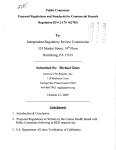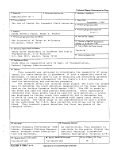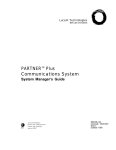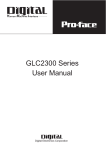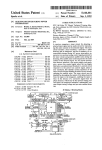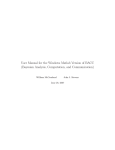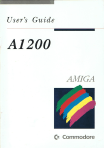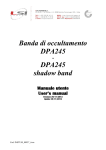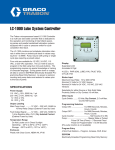Download "user manual"
Transcript
B. Electrochem 3(1) January-Februay 1987 pp 79-83 HICROPROCESSOR BASED LIFE CYCLE TESTER FOR BATTERIES M PANDIAMMAL, K MUTHU, K R RAMAKRISHNAN and Y MAHADEVA IYER Zentral Electrochemical Research Institute, Karaikudi-623 006 Life cycle testing of batteries requires sophisticated instrumentation for measurement of various parameters to evaluate the performance of batteries in the chargeldischarge mode in a production line and logging the measured values for carrying out data processing either with the help of a computer connected off line or on line. The parameters normally measured are voltage, current (chargingldischarging). time, number of cycles etc. The measurements are carried out usually under constant current condition. This paper deals with a microprocessor based charging unit for life cycle testing of storage cells and the deve\oped software is fused with the help of the EPROM programmer whose design is also incorporated in this paper. LIFE CYCLE TESTER FOR BATTERIES r ne present system described here is a microprocessor based battery life cycle tester, with software for fixing the charge/ iischuge cycle and multiplexing of cells upto 256 nos. The unit s easily expandable with proper addition of peripherals to evaluate any paramettr. Software modification can be easily carried out mlike in other rigid modules, to meet any specific testing demand. Since the development of the storage cells being an ongoing proiect, the present system described here enables acquiring and logging of a large number of data for further processing. SYSTEM DESCRIPTION The proposed system consists of scanning a series of individual :ells which are either in changing mode or discharge mode. The :ells are charged with constant current chargers or charging through - I I ?-A& -MULE TIMER 62s UP 0085 - fi KEYBOARD Fig. 1: Battery tester schematic &- I I, resistors or SCRs. The cells are also discharged under constant current or through a resistor or through SCRs. The individual cell voltages scanned are logged in RAMS which are expanded upto the level required using the bus expansion facility of SDK 85 kit. The set high voltage (El) is compared every time during charging and the cells are stopped for charging at a high level upto 3 volts and reversed to discharging mode. Every charge and discharge cycle is logged and recorded. The timing is obtained for charge and discharge cycle from an 8253 timer if constant time chargefischarge mode is carried out, or if the limits are exceeded during charging, the tima reading is logged for reaching the voltage limits of charge and discharge. The independent timer thus enables more flexibility to the microprocessor to attend to service calls as well as sampling only. A detailed schematic diagram for a simple cell charge and discharge cycle is given in Fig.1 and the flow chart of the developed program is given in Fig.;. Pandiarnrnal eta1 - Microprocessor based life cycle tester for batteries the charging mode also, the charging is maintained at I amp. through electronic resistor. in hrs l sacond two b y i u arc in .riul 4- YES MVI, A 00 r YES G' CYCLES I f No = MO OC CYCLES .REQUIRED Fig.2: Flow chart for constant time mode FUNCTIONAL DESCRIPTION When the instrument is switched on,it changes the mode of testing to discharging mode. Then the discharge time and charge~imein hours and minutes are fed into the microprocessor through keyboard. Then the microprocessor will measure the cell voltage for every I sec. through A/D convertor 8703 and compares the lower limit of the cell voltage (E2) i.e., upto 1V. After discharge time is over, it will switch over to charging mode. The'battery will be changed to charging modc, even before discharge time is over if the cell voltage comes below lower limit. In the charging mode a d.c. power supply at 1 amp current rating is connected to charge the battery (El), as long as the battery voltage is below the upper limit (El) upto 3V. For one cycle, one discharge and one charge operations are taken. The battery will be switched over between discharge and charge modes till it reaches no. of cycles (No) for which the battery is to be put under testing. Once it reaches the required no. of cycles, then the system will come to stop. In the discharging mode, the discharge current is I amp. A D.C. resistor is used as load. 1n 80 B. Electrochem 3(1) Jan-Feb 1987 The system is built around SDK 85 with bus expansion for additional memory upto 8K bytes 11J]. A programmable timer 8253 is used in hardware interrupt mode. Most part of the microprocessor time is used for cell voltage monitoring and comparing with set limits (El, E2, TI & T2). The counter 0 and counter 1 are used in mode 3 and counter 2 is used in mode 0. The bytes stored in counters are in BCD form. The output of counter 0 is clock input to counter 1 and output of counter 1 is clock input to counter 2 and output of counter 2 is used for RST 7.5 interrupt. The clock output from microprocessor is given to counter 0 clock input. The charge/discharge time is fed into microprocessor in BCD form. That time byte is converted into number i.e. minutes (say 1 hour ten minutes = 70 minutes). This time in minutes in BCD form is stored in counter 2 of 8253. The period of clock input to counter 2 is made equivalent to 1 minute, i.e. frequency of the clock input to counter 2 is 1/60 Hz. So a pulse output will appear at the putput pin of counter 2 Which will interrupt the microprocessor at the end of TC (terminal count) of counter 2. i.e. at the end of charge/discharge time. At location 20 CE a microprocessor instruction is written to a subroutine program which changes the mode of the battery. Multiplexer 16% A/D converter 8703 and sample/hold amplifier are used to select batteries and to monitor the battery voltage. Port A of 8255 is used for outputting signals to electronic resistors. The 6 digit display available at the kit will display the cell voltage in address field and display the charge/discharge mode in the data field. The test system described in this paper is capable of carrying out life cycle testing of nickel-zinc cells to a minimum of one to a maximum of 8 Nos. It could be expanded to 256. The instrument can also be easily expanded to record data such as temperature, state of charge, capacitance, internal resistance etc. for which work is being carried out in this lab. The specifications are as follows for the testing system. Mode: I . Constant time charging/discharging 2. Fixed number of cycles of charging/discharging 3. Endurance mode, voltage sensing mode and recording maximum number of cycles Charging cutoff voltage (El) : upto 3 volts Discharging cutoff voltage (E2) : upto 1 volt Charging/discharging current : 500 mA to 10 A for each cycle Max. No. of cells to be connected : 8 (256) Programme. listing can be supplied on request. EPROM PROGRAMMER In a computer or in a microprocessor based system memories are required for storing informations like data, instructions etc. @,4]. ROM or EPROM is basically a non-volatile memory. This means, even when the power to the memory is switched off, the stored contents are retained. The contents. of ROM are either ~ L xuoa Fg.3:Circuit diagram for EPROM programmer blown by the manufaduras at the time of manufacturing or by 4. Load the informations (to be blown into 2716) in RAM location starting from 8000 the user with the aidof specialp~ogrammasliketheoaepresented here. To meet the changing req - ofthew.Erasabkand 5. Execute the program mess, Go. 2NM. EXE) Reprogrammble R d Only Memories - EPROM chips are 6 . Xemove + 25V supply + 5 v supply Now the information has been transferrd from RAM to EPROM and stored. 7. Remove avaihble. The prol;.r;MM-d wnslsrs of 8255 PPI chip, the manory chip to be programmed and a push butLon swaeh to wnmct a + 25V READING THE INFORMATION FR6M EPROM or + 5V supply to the program pin of 2716. It is shown in Fw. 3. The developed prunit bas a Euro edge wnnedor for After programmi'lg, it is necessary to verify the contents of connectingtheunitwiththcSDK85micropocessorLitduring~ EPROM. For this the following stshould be followed in ~ramminsand program sequma- rq- The flow chart of the monitor Wing to enable carrying out pr* gramrning and readiog the EPROM is given in figs. 4 and 5 respectively. For progmnming the fobwing steps are followed in sequence. 1. + 5V is applied to Pin No. 24 of 2716 2. + 25 V is applied to Pin No.21 of 2716 3. h a d theprogramin RAM(8155)fromstamngaddressaDOO 1. Apply + SV to Pin No. + 5V to Pin No. 24 of 2716 21 of 2716 3. Load the program in RAM from starting addrqss 2050 4. Exccrrte the program (Go, 2050. EXE) 5. Now the address will appear at the address field and the data wiU appear at the data f ~ k of l the display. 2. Apply Thc software in the read mode provides facility to eiiher increment or damment the address by the use of separate incrementhg (Next) and decrementhg (EXE) keys, so as to enable forward and backward search of the stored data in EPROM. 6. Ekvuchern 3(1), Jan-Feb 1987 81 Pandiammal eta1 -- Microprocessor based life cycle tester for batteries REGISTER PORlS INITIALISE ACC REGISTERS OF PORTS 1 0 HlGH LOGIC 10 OUTPUT ENABLE P I N OF E P R O M CIP 10 I BE I I B I T AOORESS SELECT SIGNAL TO EPROM I THROUGH I MOVE ME XI 8817 0 4 1 4 I0 BE PROGRAMMED F R O M R A M TO E P R O M THROUGH LATCH I u APPLY NEXT I1 BIT ADDRESS APPLY LOW TO HlGH LOGIC 1 0 PROGRAMMING P I N OF APPLY HlGH TO LOW LffilC TO PROGRAUMNG C I" TO EPROM THROUGH LATCH I SEND LOW LOGIC TO OUTPUT ENABLE PIN O F EPROM Fig.4 Flow diagram for programming The EPROM programmer is easy to construct. The circuit can be extended for programming of multiple 2716 EPROMs in parallel and also for loading different data in the different chips as well. In the latter case except for CE/PGM all like inputs of the parallel 2716s may be common. A TTL level program pulse applied to the 2716s CE/PGM input with VPP at 25V will program a particular chip, while a low level CE/PGM input inhibits all other 2716 from being programmed. Using this EPROM programmer, a microprocessor based monitor and testing systems for batteries has been designed and fabricated. L REFERENCES 1. A P Mathur, Introduction to microprocessors. Tata-McGraw ' Mi11 (1985) 2. A.P. Malvino, Digital Computer electronics. Tata-McGraw Hill (1 985) 3. MCS-85 (Intel) User's Manual, September 1978 4.8085 Microprocessor and the common peripheral LSIs that are compatible with 8085. IISc, Bangalore 5. SDK System design kit user 'smonuol # READ DATA FROM EPROM THROUG DATA BUS I - 82 0. Electrochem 3(11 Jan-Feb 1987 Fig.5: Flow diagram for program reading Pandiammal eta1 - Microprocessor based life cycle tester for batteries EPROM PROGRAMMER Wtware for r Software Locations OP Code Source 9utement 31 C2 20 Initialise stadspOinter 21 X2Xl Y2Yl Initialise H L register pair X2 X I Low Address byte Of Y2 Y, High Address byte RAM from where data is t o be transferred to EPROM 1 1 A2 A l OBI Initialise DE register pair A2Al Low Address byte OBI High Address byte 1 ) EPROM t o where DATA is to be transferred B, is 0 t o 7 01 M I M2 ON2 Initialise BC register pair M I M2 DATA IN HEX ON2 DATA IN HEX X No. of bytes to be transferred N2 is 0 t o 7 MVI, A - 80 is the code number for making port A, port B and port C as output ports in zero mode 83 is the address of command register of 8255 MOV A,D AN1 to unmask page numbers OR1 t o give High Logic to output Enable pin of EPROM STA, store this information at RAM Location 20 A0 for later use OUT 82 MOV A,E OUT 81 MOV A,M - Move Data to be programmed t o ACC LDA, Retrieve the data stored at 20A0 OR1 OUT 82, Gives a HighIogic t o programming pin of EPROM PUSH D InitiaIise DE register pair with 00, 10 D = 10 E=00 Delay subroutine in SDK-85 monitor POP D LDA, Load ACC with rne contents of 20A0 OUT 82, one data is now programmed at EPROM INXH INX D DCX B MOV A,B ORA, C JNZ, not a11 datas stored Jump t o 2010 RST 1 DISPLAY 8085 on the SDK 85 display t o indicate that programming is over. e ~ ~ ~ m n data r e d Locations DP Code Initialise stack pointer Unrmsk RST 5.5 SIM Make port A of 8255 as input port and ports B & C as output ports OUT 83 I N I T M U S E DE Register pair XlX2 Low address YlY2 High address (page number) where contents are to be read MOV A,E OUT 81 MOV A,D ANI, TO unmask page number and t o apply Low logic t o output Enable pin of EPROM IN 80 PUSH D CALL UFDDT POPD PUSH D CALL UPDAD EI RDKBD POPD CPI (Next Button) JNZ INX D CPI (EXEC Button) JNZ DCX D B. Electrochem 3(1) Jan-Feb 1987 83





